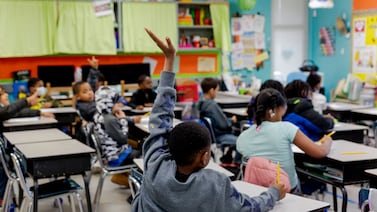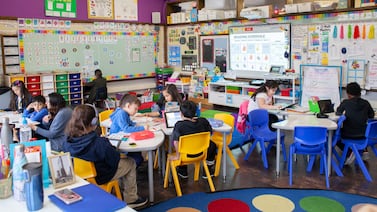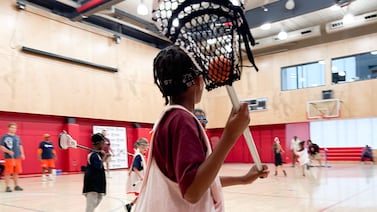School will begin in Denver on Monday the same way it ended three months ago: fully online. But district leaders are promising a more robust program than the “crisis schooling” that many students experienced when buildings shuttered due to COVID-19 in the spring.
Jayla Hemphill had very little face time with her high school teachers in April and May.
Instead of being in class for seven hours a day, she had a couple of video calls a week. If she had a question, she could chat with a teacher and be off within 15 minutes. Even though her teachers posted her weekly assignments on Monday, Hemphill said she usually wouldn’t do them until Thursday and Friday, essentially giving her a five-day weekend.
Hemphill liked the flexibility. It allowed the 16-year-old to get a part-time job making pizzas, watch her little brother while her mom worked nights, and get more involved in political activism.
But not everyone liked the leeway of Denver Public Schools’ approach to remote learning. Some students and parents wished schools had provided more real-time online teaching.
“We think any live interaction is better than self-guided tasks,” said Darren Malia, who along with his wife helped his two young children navigate remote learning. “If they’re ‘live’ with a teacher for an hour or two, that’s an hour or two that we can do the things we need to do.”
Based partly on parent feedback, the district has made a U-turn in its guidance on remote learning. Whereas in the spring, the district gave teachers a choice to offer live video instruction or not, Denver is now requiring them to conduct at least three hours of live lessons per day.
That’s not the only change. The district is using a single online learning platform for elementary schools and another for secondary schools, instead of asking students and parents to remember instructions, usernames, and passwords for a half dozen. The district has also tightened expectations around attendance and grading to more closely mimic normal school.
“Last spring, when we shifted on very little notice to remote learning, we really were only able to do ‘crisis school,’” Superintendent Susana Cordova said during a recent live Q&A on Facebook.
“For many of our teachers, they had never worked in a remote environment,” she said. “So the quality and duration of what happened was very uneven across the city. It was very much responsive to what was happening, but it was not necessarily planned out.
“This year,” Cordova added, “our expectations have really changed.”
A quick pivot
In a survey of nearly 20 Denver parents, interviews with 10 more, and interviews and panel discussions with more than a dozen high school students, no one blamed the teachers.
Teachers had to pivot quickly; online classes started three weeks after schools shuttered in mid-March. District leaders encouraged teachers to record their lessons so students could watch them anytime, and to give students several days to complete assignments. District surveys show that about 85% of teachers followed that approach.
Attendance was loosely defined, and district data shows 89% of students engaged in remote learning in some capacity. Only 140 students out of 92,000 didn’t engage at all.
Elementary and middle school teachers weren’t required to grade students’ work. High school students could choose whether or not they wanted to receive letter grades, with the understanding that their grades would only go up, not down. About 42% of students chose not to receive letter grades for at least one class, district data shows.
The district figured this type of flexibility was most equitable: If a first-grader was home during the day with a grandparent who wasn’t tech-savvy, he could wait to do his schoolwork until another family member could help. If teenagers were babysitting younger cousins, or picking up extra hours at after-school jobs, they could watch their lessons when they were off work. If life circumstances prevented them from participating at all, they wouldn’t fail their classes.
But the approach had drawbacks for some students and parents.
Some students blew through their assignments. What teachers said would take three hours every day only took Stephan Pfeifer’s children 45 minutes. “They don’t need a 10-minute video and the rest independent study,” he said. “They need a real lesson.”
Other students struggled to stay motivated. When they did have live lessons — or, more commonly, weekly check-ins with teachers — students said it was easy to tune out.
“You’re at home, on a computer, you can turn your camera off, or go on mute, or go on your phone during the class,” said Elliot Guinness, who will be a high school junior this year.
He added, “I’m not saying I’d do that stuff. But hypothetically, a lot of kids would.”
Parents sometimes had trouble keeping tabs on their children’s work.
“My son would tell me, ‘I’m getting all my assignments in,’ and I was believing that until I started getting the emails and phone calls,” said Linn Stanley, whose son is in middle school.
His teachers were using at least four online systems to assign schoolwork. Even though Stanley does tech support for a living, she had trouble figuring it out. “It was sort of embarrassing that I was like, ‘I can’t figure out where I’m supposed to see what you’re doing,’” she said.
Other families had trouble connecting to the lessons at all. Cordova estimated it took six weeks to distribute all of the district’s available computers and internet hotspots — and still, not all students had them. It took even longer to start distributing paper worksheets, she said.
And the technology problem still isn’t solved: Global supply chain issues have delayed shipments of new computers. The district estimates as many as 3,000 students could lack a device when school starts Monday. About 3,600 could still need internet access.
‘A little bit of a mess’
Teacher Montserrat Contreras used a similar approach at the Denver charter school where she teaches Spanish. She’d post lessons on Monday that were due Friday, and she’d hold an hourlong video call each day for students to ask questions. But she had more than 100 students spread across her classes, and she admits the calls were “a little bit of a mess” at first.
Some of her students — especially the social butterflies who loved to chat in class — shined without classroom distractions. But she said others floundered without the daily structure of in-person school. And she said the academic pace was not as rigorous.
“I do think we somewhat lowered the standard,” she said.
Beth Gish teaches students with autism at a Denver high school. The prerecorded videos didn’t work for her students, she said. Her students need interaction. One day, when a teenage boy was manifesting some frustration with his mother by biting his hand and hitting his head on the wall, Gish hopped on a video call to help calm him down.
“We went to FaceTime and started putting hats on each other” using one of the app’s filters, Gish said. “We did that for two hours.”
Sarah Smith, who teaches third grade in Denver, was one of the 15% or so of Denver teachers who held live lessons every day. From 9 a.m. to 10 a.m. she held a morning meeting and did a math lesson. From 12:30 p.m. to 1:30 p.m. she read books out loud and taught literacy.
“I felt for the parents because I am a parent as well,” said Smith, who has two children. “I did not feel their job needed to also be homeschooling their child. I felt like if I’m going to give [the students] assignments and work, I’m going to be in charge of that.”
All of Smith’s students showed up, and she was able to get through the entire year’s curriculum. But she said the lack of clear expectations from the district was troubling.
“‘Have grace,’ that’s the word that kept going around, which we completely understood,” Smith said. “A hard part for me and other teachers was that there was not really guidance: Should it be new learning or review? It was a lot of make it up and do whatever.”
New expectations
Starting Monday, the district will require elementary school teachers to teach live online lessons at least three hours per day. Middle and high school teachers will be required to teach live for at least 3½ hours. Teachers may also hold “office hours” or work with students in small groups, two strategies district leaders said worked well in the spring. And all students will get at least 20 minutes a day of what educators call social and emotional learning.
District leaders have always believed live lessons are important, said Tamara Acevedo, deputy superintendent of academics. It’s just that now, with a couple months of remote teaching under their belts and a couple more weeks of preparation and training this summer, Denver teachers are in a better position to do it well, she said.
In the spring, she said, “we needed to mobilize quickly and we wanted to set up students and teachers with options to do that in ways they could implement quickly. With more time and work, we’re able to support that live instruction and teachers’ ability to do that more.”
Whereas the district emphasized flexibility in the spring, the goal for this fall is fluidity, she said.
Across the district, teachers will be using the same online platforms: SeeSaw for elementary school and Schoology for middle and high school. If students return to school buildings in mid-October, as is currently planned, they can bring their computers and continue the learning they had been doing at home. If there’s a COVID-19 case in their class and they need to quarantine, they can take those computers home and not miss a beat.
“This is the opportunity to truly be one-to-one,” Acevedo said, referring to each student having their own computer, “and it just has such implications for what we’re able to do.”
Teacher Joe Bolz said he and his team feel more prepared. If the spring felt like teachers were in their own lifeboats, rowing in different directions, “we’re all looking in the same direction now,” he said. He and his team even planned to practice live teaching with each other this week.
Some parents have complained that three or four — or seven — hours in front of a computer is too much for students. But parent Natalie Perez said she is hopeful about the new format. She’s especially hopeful that she’ll no longer be a de facto elementary math teacher.
“I feel like now we’ll have more support and that face-to face-is going to be helpful,” said Perez, whose young son sometimes hid behind the couch when he got frustrated with his remote math lessons. “It’ll be less stressful than it was during the spring.”






